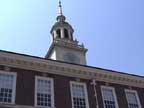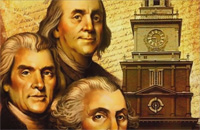

National Standards for Civics and GovernmentII. What are
the Foundations of the American Political System? III. How Does
The Government Established By The Constitution Embody The A. How are power
and responsibility distributed, shared, and limited in the National Standards in Civics and Government from the Center for Civic Education: V. What Are the Roles of the Citizen in American Democracy? |
We the People: Constitution and Citizenship Day We the People of the United States, in Order to form a more perfect Union, establish Justice, insure domestic Tranquility, provide for the common defense, promote the general Welfare, and secure the Blessings of Liberty to ourselves and our Posterity, do ordain and establish this Constitution for the United States of America. - Preamble to the U.S. Constitution In 2004, Congress passed a provision in the Consolidated Appropriations Act, 2005 establishing a day to commemorate the September 17, 1787 signing of the Constitution. Senator Robert Byrd of West Virginia, who inserted this mandate into the bill, felt this was a way to educate Americans about history. President George W. Bush signed it into law on December 8, 2004. Designated as Constitution and Citizenship Day, schools receiving federal money are required to hold an educational program about the United States Constitution each year. Schools may choose what kind of program to hold. Starting Points Ben’s Guide to U.S. Government for Kids A caricature of Ben Franklin leads learners of all ages in finding information about the Constitution and the United States Government. Primary grade students learn of the three branches of government. Intermediate grades find information on the separation of power, checks and balances and the Articles of Confederation. Middle school students learn about making laws, national verses state government, the election process, and historic documents. Detailed information on federalism, powers of national and state governments, and how laws are made are written for grades 9-12. High school students are invited to engage in a national debate topic. Debate topics for the past six years are included. America's Founders online provides portraits of 24 individuals who who framed our constitutional republican system of government. People like Abigail adams, Thomas Jefferson, and George Mason are among those highlighted with biographical information and famous quotes.. Charters of Freedom: The Constitution Which state did not send any delegates to the Constitutional Convention? Who insisted that the Bill of Rights be adopted. Who gave the most speeches? Begin your research at the National Archives where you can view original documents, read transcriptions, and gather biographical information about the founding fathers who attended the 1787 Constitutional Convention in Philadelphia. High resolution images of documents can be downloaded for printing and observation while changes in the U.S. Constitution are indicated with links to the current verbiage or amendment. In addition, there is an article about the restoration of the historic murals found in the rotunda of the National Archives. Teachers will want to use this site for preparing lessons. Continental Congress Broadsides In a special presentation from the Constitutional Convention Broadsides collection, students will learn about the process by which the constitution was drafted and revised. From the abandonment of the Articles of Confederation to the penning of a final version of the U.S. Constitution, students will recognize that it was no easy task to ratify this new form of government. Drafts were kept secret, amendments were presented, and fierce debates ensued. This compelling information is highlighted with documents, images, and short biographical sketches. Click on different topics to view suggestions on how this collection might fit into a lesson on persuasive writing or creating a broadside. A wealth of search strategies will guide the high school student deeper into critically thinking about the impact broadsides had on the population during that time period. Rounding out the presentation is a timeline of America during the Age Revolution. The Library of Congress provides a rich source for primary sources from broadsides to period illustrations that definitely will enhance the study of the Constitution. One middle school teacher used illustrations from this and other collections to teach about it in her classroom. In addition, she created a Who Signed the Constitution quiz to complete using an interactive PowerPoint slide show. She was amazed at how engaged her students were when they recognized the individuals they had researched. This teacher had transformed a dry topic as she described it into living history with just a few illustrations. Constitution Day commemorates the formation and signing of the U.S. Constitution by thirty-nine brave men on September 17, 1787, recognizing all who are born in the U.S. Wow! Centuries of Citizenship: A Constitutional Timeline is a phenomenal presentation spanning years of history. Period music and sounds are provided for each decade. At each stop along the way, you can choose to hear about the era, listen to a Point/Counterpoint, learn facts, and participate in an interactive questionnaire to determine if you could vote during that year. This is an excellent introduction to key events while allowing students to think about the issues. Do not miss visiting this site! In addition to the timeline, there is an interactive Constitution based on Linda Monk’s The Words We Live By that allows students to search by keywords, specific topics, or court case. Detailed explanations are provided along with viewpoints and Supreme Court Updates. This website is a program of the Annenberg Center for Education and Outreach and is an excellent source for historical and current Constitutional discussions. Citizenship and Democracy Committee for Citizen Awareness The Committee for Citizen Awareness is a non-partisan organization established in 1985 to promote democracy, citizenship, and voting. Excerpts from six video clips narrated by such well-known figures as Caroline Kennedy, Supreme Court Justice Ruth Bader Ginsburg, and former Secretary of Education Richard Riley are provided as a preview to the complete video. The titles include, The U.S. Congress and You, Your Court System and You, The Executive Branch and You, We the People…The U.S. constitution and You, Patriotism and You, and Where We Stand. Each video clip is accompanied by a synopsis, viewer feedback, and a list of sponsors. The CCA sends a copy of the videotapes with explanatory materials to each of the following organizations within the congressional district being sponsored: every public and private high school , every community and junior college, the major public libraries, the major chambers of commerce, and the cable television facilities within the sponsored district. Check to see if you fall under one of these categories. You can contact the Committee for Citizen Awareness at info@citizenawareness.org. The Constitution: That Delicate Balance Sign up to view free videos prepared by the Annenberg Foundation. Prominent individuals spontaneously debate the pros and cons of controversial issues such as the right to die, first amendments rights, and immigration. Supporting resources further enhance the learning experience by examining democracy, citizenship, and primary sources. Videos on this site are gathered together from a variety of reputable organizations that produce high quality educational media. Constitutional Rights Foundation Educating Tomorrow’s Citizens The Center for Constitutional Rights is dedicated to advancing and protecting the rights guaranteed by the United States Constitution and the Universal Declaration of Human Rights. CCR is committed to the creative use of law as a positive force for social change. We do that by combining cutting-edge litigation, advocacy and strategic communications in work on a broad range of civil and human rights issues. Lessons In Congress Assembled: Continuity and Change in the Governing of the United States The American Memory collection at the Library of Congress includes a teaching unit on the Constitution, Congress, and current events using Thomas Legislative and Documents of the Continental Congress and the Constitutional Convention collection. Using these primary resources four lessons examine continuity and change in the governing of the United States. Documents are used to study the Constitution and Bill of Rights in lessons one and two. Lesson three investigates important issues that confronted the first Congress. Broadsides from the Continental Congress that called for special days of remembrance and thanksgiving are used to teach lesson four. Each lesson includes a preliminary activity, discussion, culminating activity and extensions. Engage students in the process of amending the Constitution with C-Span’s classroom materials. Examine an overview of the procedure by reading a Bill from Congress and a Bill from the Constitutional Convention. Assess student understanding of the process with the review and discussion questions that are provided. View a video to determine how Woodrow Wilson’s presidency led to the creation of the 25th Amendment and view a video of President Bush speaking on a recent joint resolution. Explore the three branches of government through engaging questions with links to information and answers. Test student knowledge of the legislative, executive and judicial branches of government with quizzes. Hone vocabulary skills with definitions related to each branch of government. C-Span’s activities are linked to state and national standards. Many videos and activities are included to make this an invaluable site when studying the United States Constitution. Want to locate quick links and information about the U.S. Constitution? Need some ready-made constitutional questions with the answers a click away? Want to participate in a survey on a current events issue or ask a question? Then, head straight for the U.S. Constitution Online. We the People: Behind the Scenes with Benjamin Franklin The U.S. Constitution is a living, flexible document that is the foundation of American government. Benjamin Franklin played a key role as elder statesman at the Constitutional Convention in 1787. Join Dr. Franklin as he shares his views about the framing of the U.S. Constitution in the town where history was made - Philadelphia, Pennsylvania. Celebrate Each year as the signing of the U.S. Constitution is celebrated, more and more Americans will be made aware of the founding fathers and their ideas for government rule that have lasted over two centuries. This is an opportunity to educate all students about the basic principals of democracy to the more complex constitutional issues that are in the news today. |
Videos
Independence Hall
|
||
|
||||
© 1996 - 2015 Linda C. Joseph
All Rights Reserved
All CyberBee Graphics are Trademarked
Graphics by
Darlene Vanasco/Creative Director
Erika Taguchi/Designer & Illustrator
Hosting Provided by Iwaynet

